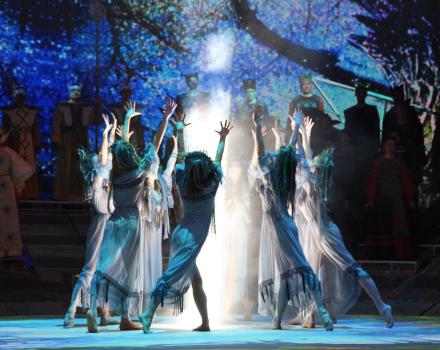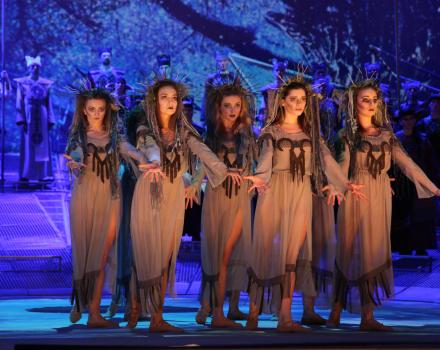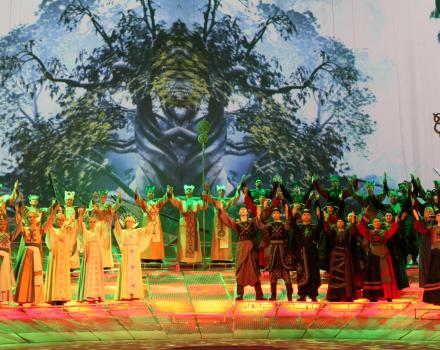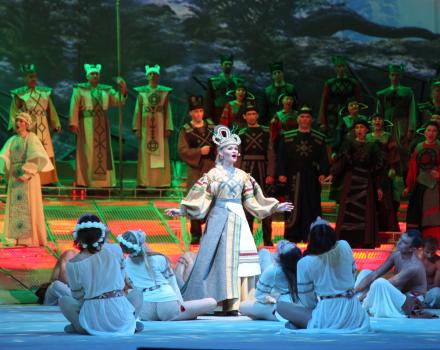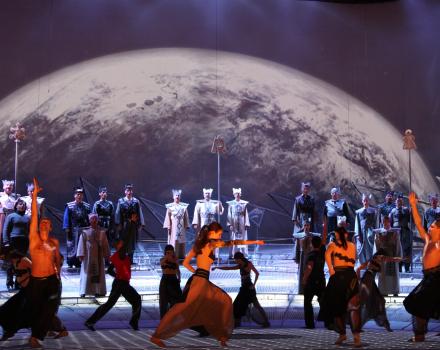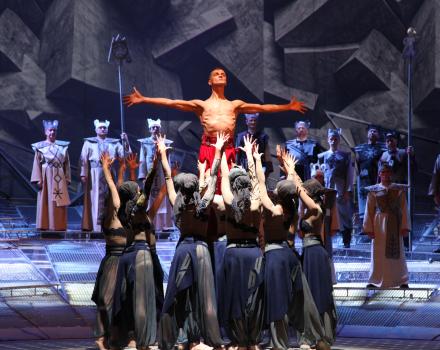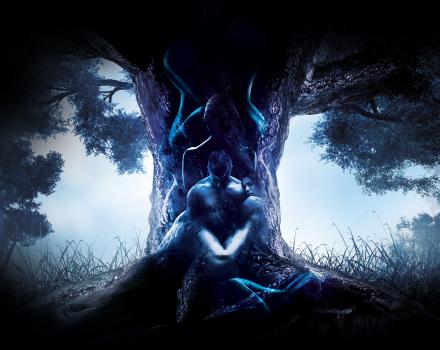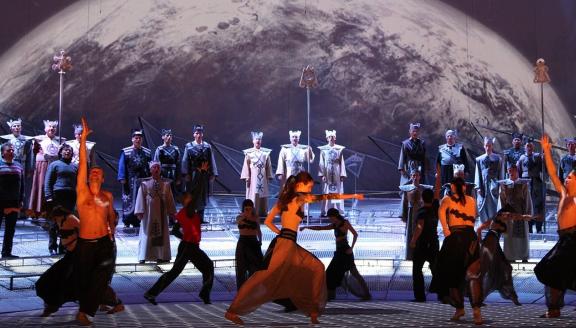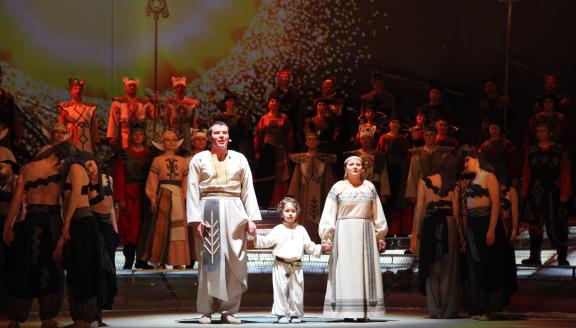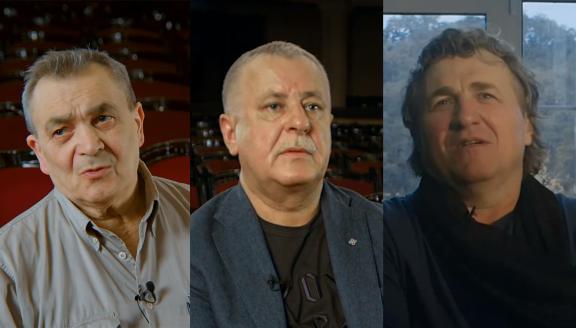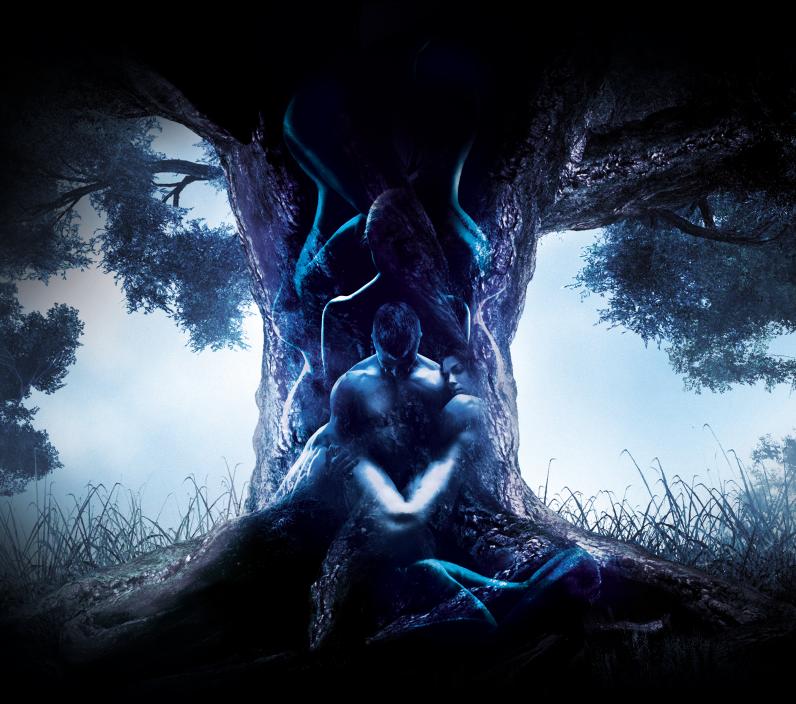

Part folklore, part opera-ballet, this féerie presents local pagan traditions on the day of the summer solstice and historical events from Cossack times to the more recent 2014 Ukrainian Revolution of Dignity.
After forty years of oblivion and ban by the Soviet authorities, Ukrainian composer Yevhen Stankovych's opera-ballet When the Fern Blooms finally premiered at the Lviv National Opera in 2017. Unique in its genre, this impressive performance combines millennia-old folk traditions with an expressive musical language, choral singing and contemporary choreography set against spectacular scenery.
Cast
|
Principal / Soloists
|
Nina Matviienko, Mykhailo Malafii
|
|---|---|
|
Chorus soloists
|
Olena Romaniv, Iryna Chikel, Liliia Sobchyshyn
|
|
Principal dancers
|
Serhii Kachura, Dariia Kosmina,Nataliia Pelio, Olena Chernichenko, Mariia Potapova, Zoriana Dvorska
|
|
Ballet
|
Lviv National Opera Ballet
|
|
Chorus
|
Lviv National Opera Chorus
|
|
Orchestra
|
Lviv National Opera Orchestra
|
| ... | |
|
Music
|
Yevhen Stankovych
|
|---|---|
|
Conductor
|
Volodymyr Sirenko
|
|
Director
|
Vasyl Vovkun
|
|
Sets
|
Tadei Ryndzak
|
|
Lighting
|
Dmytro Tsyperdiuk
|
|
Costumes
|
Hanna Ipatieva
|
|
Text
|
Oleksandr Stelmashenko
|
|
Chorus master
|
Vasyl Koval, Iryna Koval
|
|
Film production
|
The Little Films
|
|
Film director
|
Serhii Krutsenko
|
| ... | |
Video
The story
Act I. ‘Kupala’
'Human Kupala Night', 'Mermaid Kupala Night', 'Witch Kupala Night', 'Fern Flower'
Summer solstice. The magical power of the Kupala bonfire. Jumping over it, people go through the ritual purification. At Kupala Night not only humans, but also mermaids and witches join the celebration.
The legend has it that the flower of the fern – a dream flower with magical properties – blooms for a moment on the shortest Kupala Night. Does this flower symbolise the moment of love, a liberating passion that helps to understand human nature and the world on the shortest summer night?
Act II. 'Heroic'
The ‘golden age’ of the legendary pagan times or the humanist era, where the harmony of man and nature prevailed in all its manifestations of the completeness of being, is contrasted with the era of humanitarian crises, the threat of wars and chaos in Ukraine starting with the Cossacks to modern times.
Weapons are forged.
Battles are raging.
Death is coming.
The hope of a newborn son, blessed by his native land and his mother, is the future of Ukraine, its leader and sage.
Insights
5 things to know about When the Fern Blooms
1° What can I expect?
Yevhen Stankovych’s piece When the Fern Blooms is hard to classify. Part folklore, part opera-ballet, it is its very own genre. With it, Stankovych pioneered a neo-folkloristic style that recreates an archaic sound while borrowing from modern compositional techniques. He combined his own compositions and arranged well-known Ukrainian folk songs, creating a polymelodic mosaic full of contrasting scenes and episodes. You’ll search in vain for an overarching plot, for classic arias or duets. Instead, you’ll be immersed in thousand-year-old folk traditions and get a panorama of Ukrainian history from Cossack times to the more recent Revolution of Dignity in 2014.
2° Does the fern really bloom?
The old belief of blooming fern flowers is linked to Ivan Kupala Day, the summer solstice festival traditionally celebrated in Ukraine and its neighbouring countries Russia, Belarus and Poland. It is usually observed on 7 July according to the Gregorian calendar, corresponding to St John’s Day. Until modern times, the Slavic Midsummer Night gave rise to a spectacular pagan festival.
Many Ivan Kupala customs are associated with water, fire, unfolding magical powers of plants and self-purification. Young women would lower wreaths of braided flowers with candles into rivers and read their own future by their drifting in the water. Young couples would jump over a bonfire. Most importantly, the night of Ivan Kupala is said to be the only time of the year when ferns briefly bloom. Whoever finds a fern flower on Ivan Kupala is said to be able to see all the treasures hidden in the earth with the help of the flower. That is why many people searched the forests on Ivan Kupala for magical ferns in bloom.
3° Gogol’s afterlife
When the Fern Blooms is based on Gogol's stories ‘Taras Bulba’ and ‘St. John's Eve’ from the story collection ‘Evenings on a Farm Near Dikanka’. In ‘St. John’s Eve’, a young man finds the fantastical fern flower but is cursed by it. The legendary Witches' Sabbath at Ivan Kupala also inspired Modest Mussorgsky to write his symphonic poem Night on Bald Mountain.
While many composers drew inspiration from the Ukrainian writer’s oeuvre to write operas, not all were receptive to the same elements in his work. Shostakovich’s first opera The Nose, for instance, is based on a satirical short story. Stankovych, however, joins the ranks of composers like Mussorgsky with Sorochyntsi Fair, Rimski-Korsakov’s with May Night and Christmas Eve and Tchaikovsky with Vakula the Smith (later reworked as Checivhki) before him, who were influenced by Gogol's depiction of pre-Christian archaisms, superstitions, demons and (super-)natural phenomena.
4° Why was it banned?
When the Fern Blooms was commissioned by the French concert company Alitepa for the World Fair in Paris and was to be performed as part of a guest performance at the Opéra de Paris. The premiere was to take place in 1979 at the Palace Ukraine in Kyiv, Ukraine. French representatives were invited to attend. During the dress rehearsal, the Soviet statesman Mikhail Suslov, who was present, sent a letter from Moscow to ban the performance. The Soviet authorities cited technical reasons as the reason for the ban. Sets and costumes were even destroyed.
One can assume that the real reason was the authorities' fear that the impressive portrayal of national Ukrainian culture might stir up patriotic feelings. In the end, the opera's avant-garde neo-folkloristic style was incompatible with the ideologically accepted art form of ‘socialist realism’ in the Soviet Union. Despite the fall of the Soviet regime in the 1990s and the great interest in the work, the opera was not performed in its entirety for almost forty years.
5° Rebirth
After these decades of oblivion, a complete stage version of When the Fern Blooms was finally performed at Lviv National Opera in 2017 and entered the regular repertoire. A new generation of artists collaborated with the composer to create a magnificent spectacle combining modern music, choral singing, modern choreography and scenography with video projection. The artistic director of the opera, ‘people’s artist of Ukraine’ Vasyl Vovkun directed the production. For him, the premiere marks the beginning of the realisation of a ‘Ukrainian breakthrough’, opening the possibility of revival, reinterpretation and popularisation of operas by Ukrainian composers whose significant works have remained unknown not only in Western Europe but also to many Ukrainians until now.
The new production of When the Fern Blooms returns to the past, embraces the present and connects with the future. For the music professor and critic Adelina Yefimenko, the opera’s place should be in the European musical canon. ‘Every composer tries to express in sound his ideas about the continuity of the past, present and future. This is how the Ukrainian folk opera When the Fern Blooms should be interpreted. The new production of Lviv National Opera for the first time opened the door for this outstanding composition, which belongs to the cultural heritage of European music history.’
Gallery
